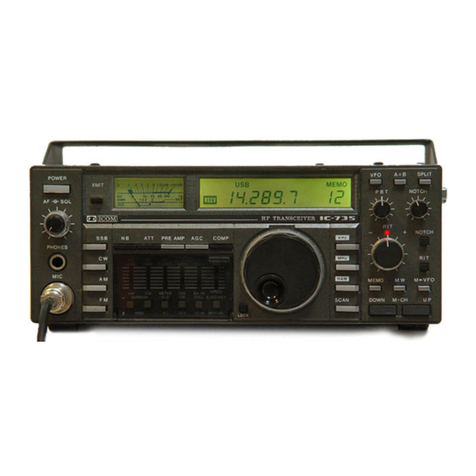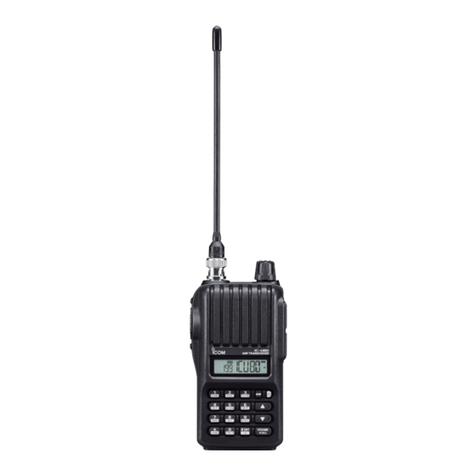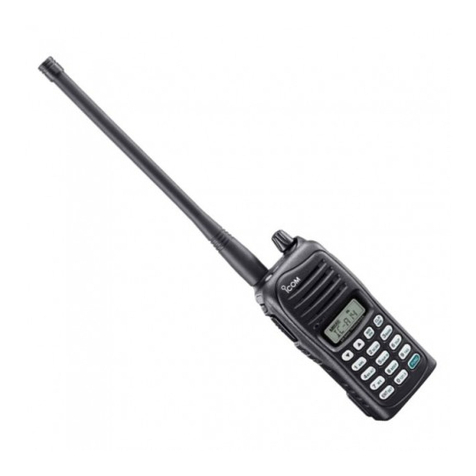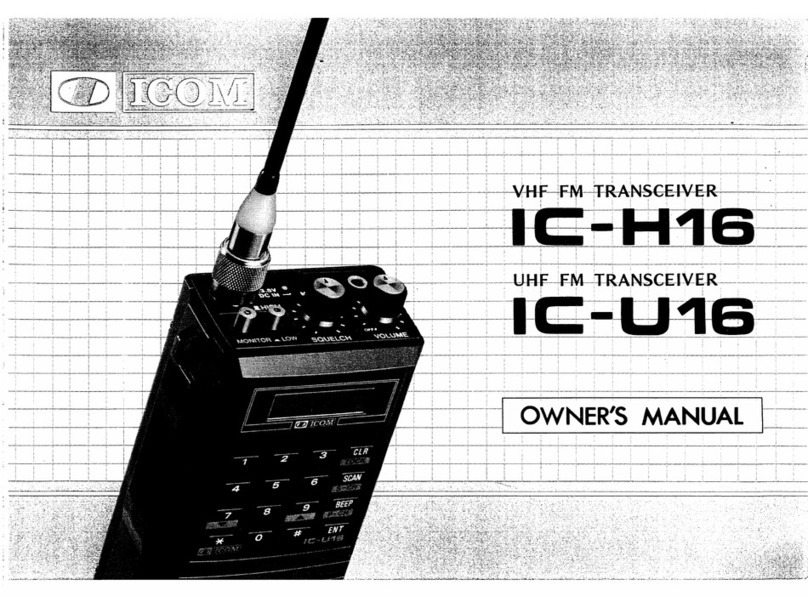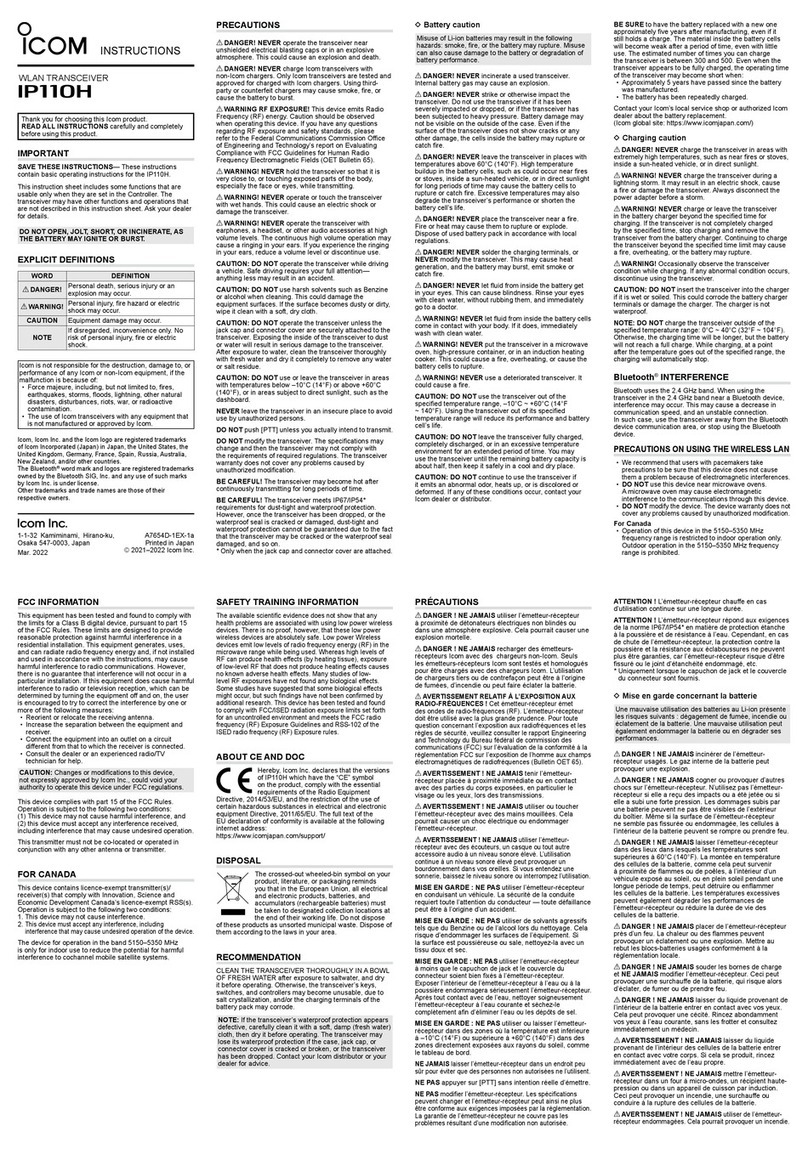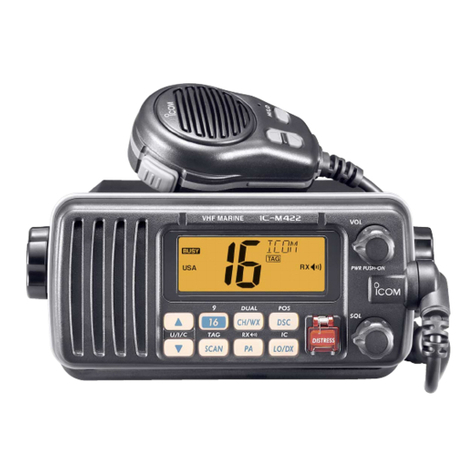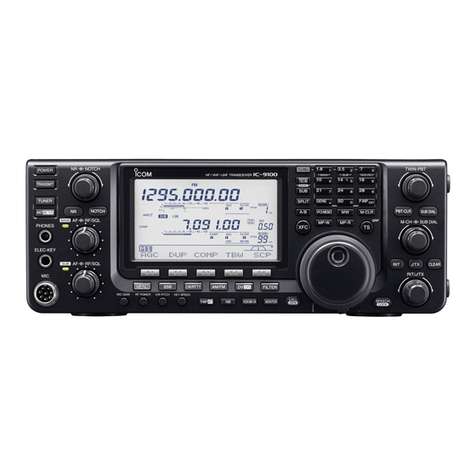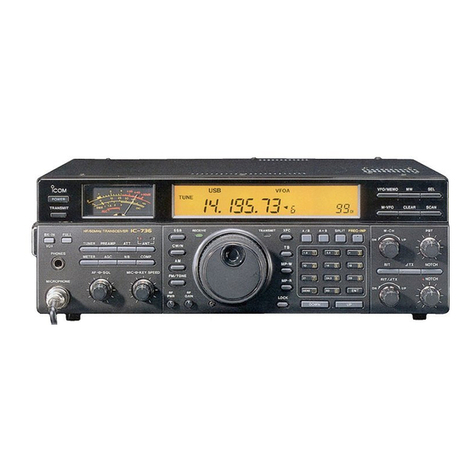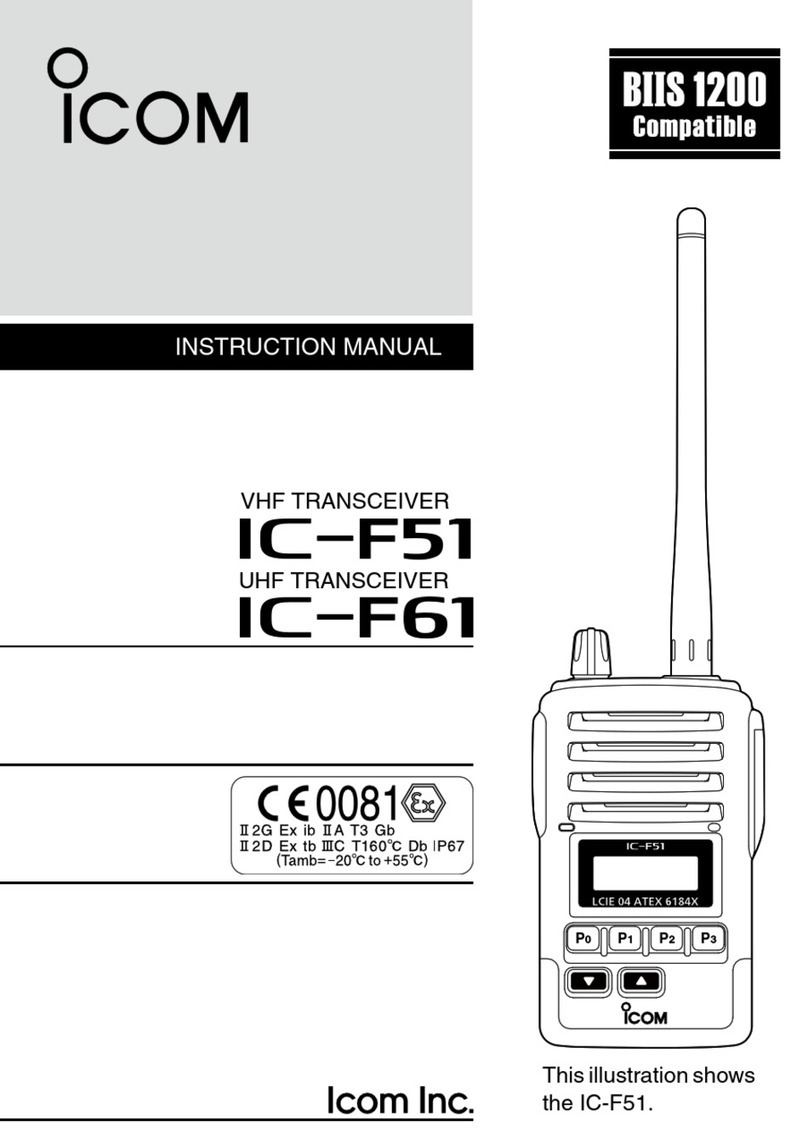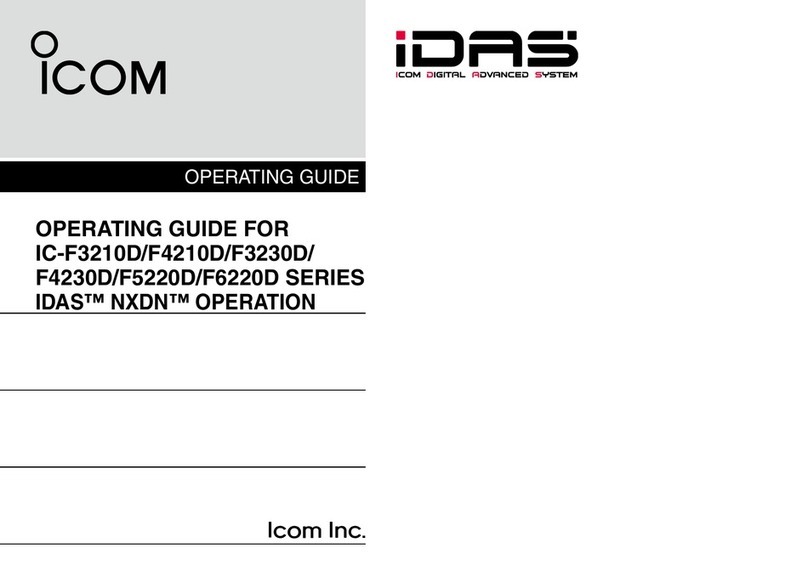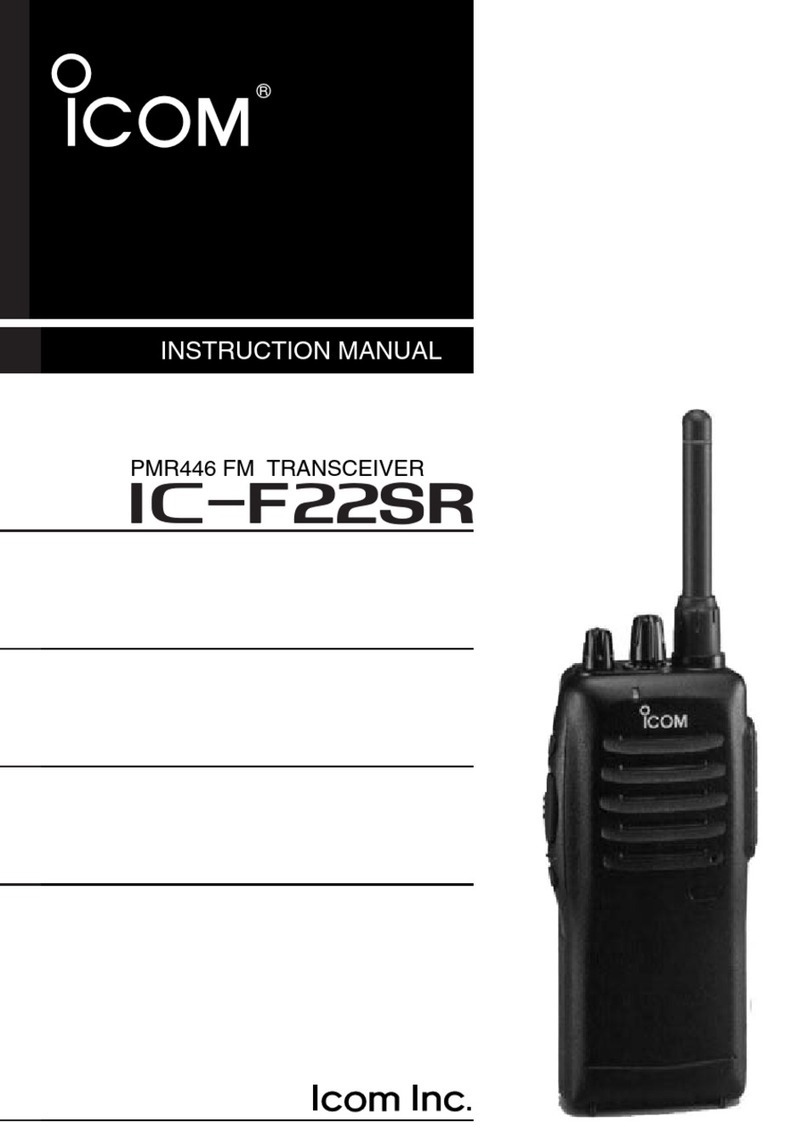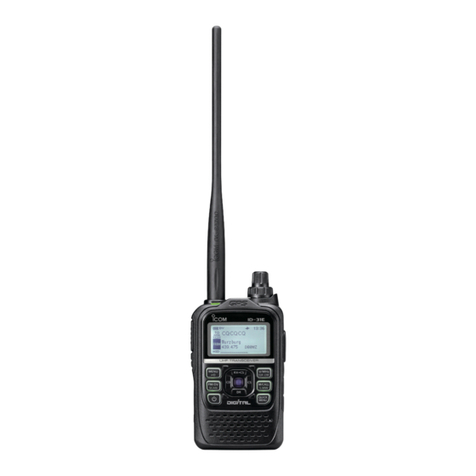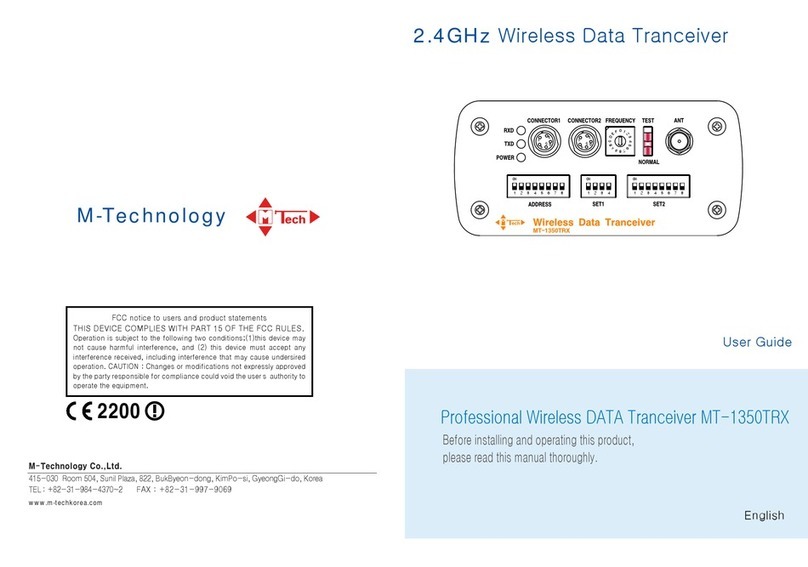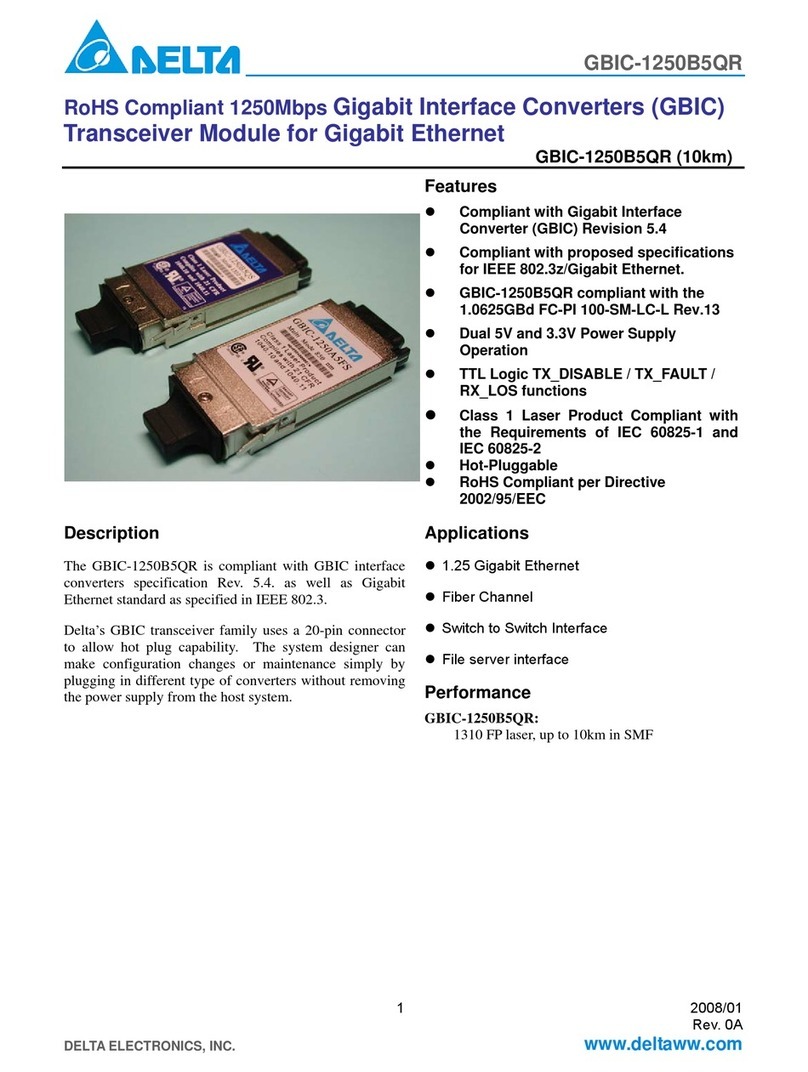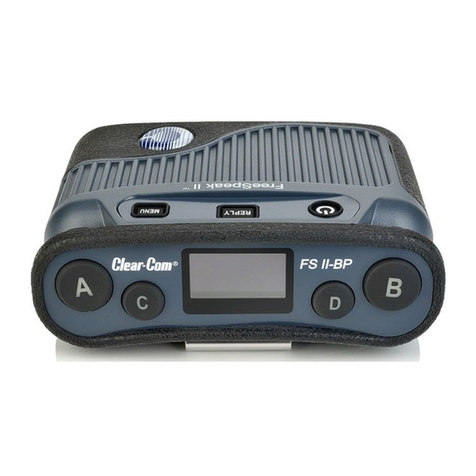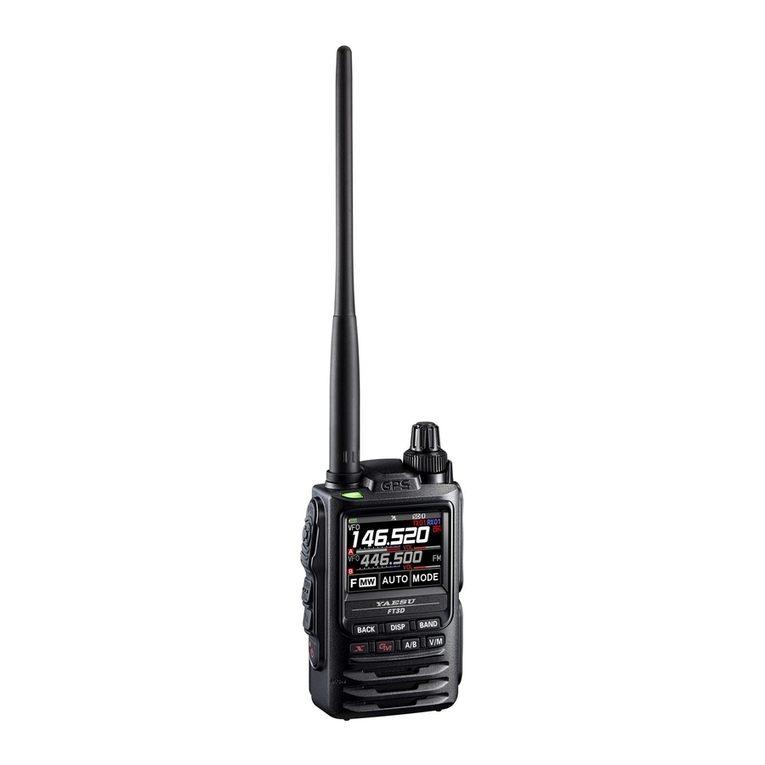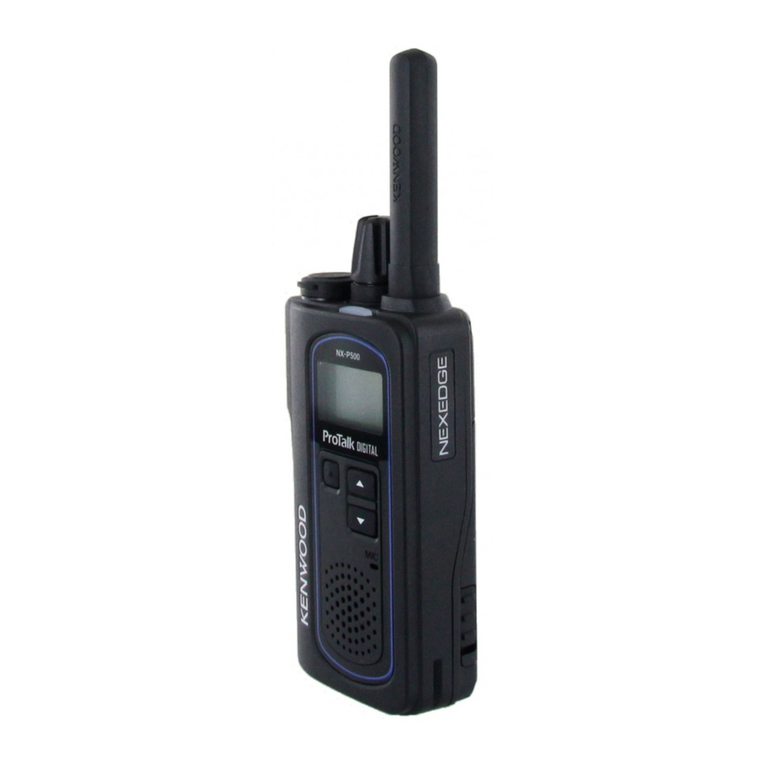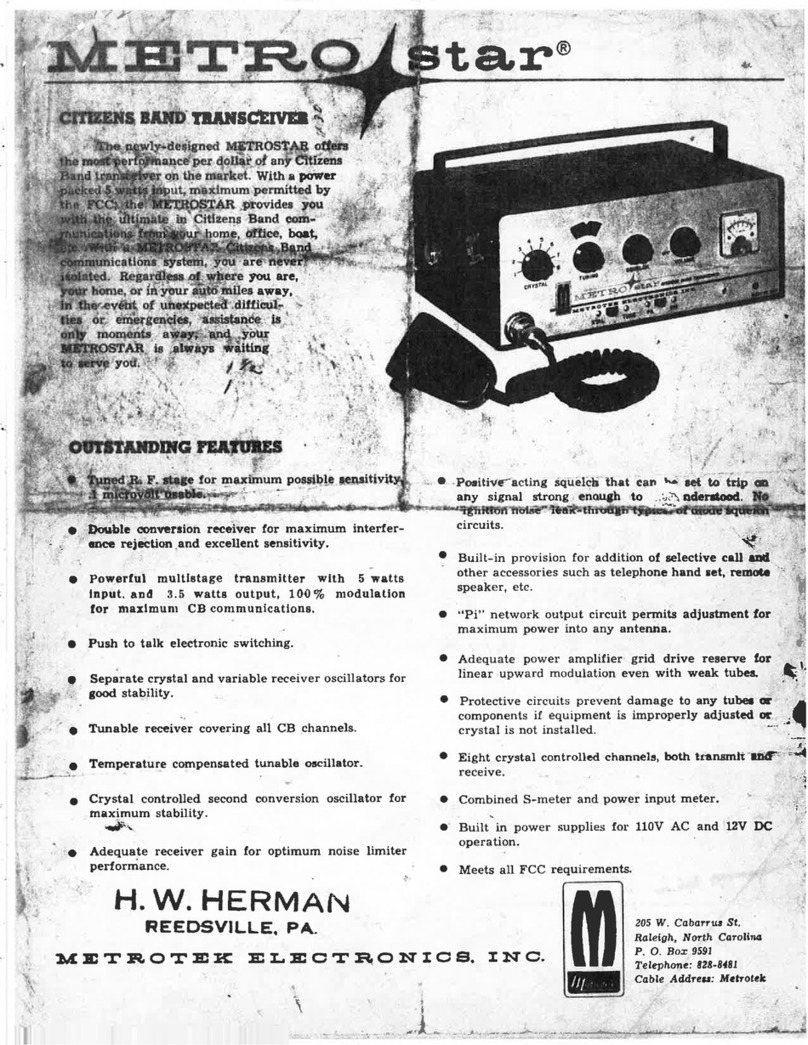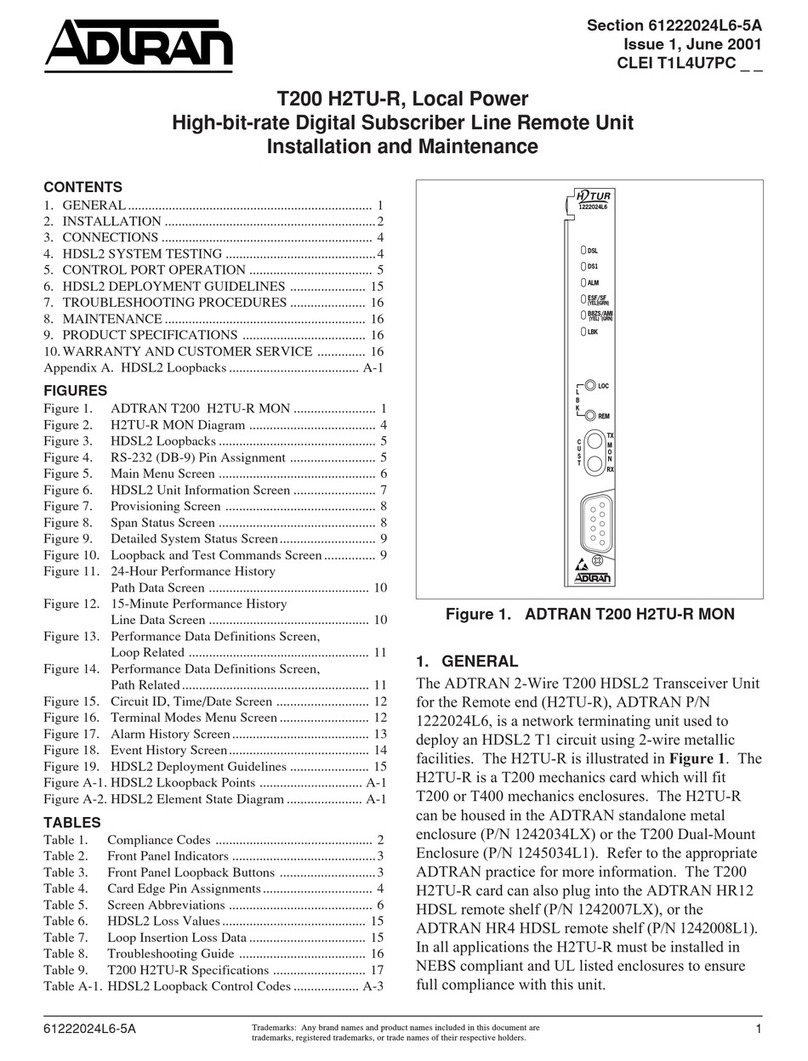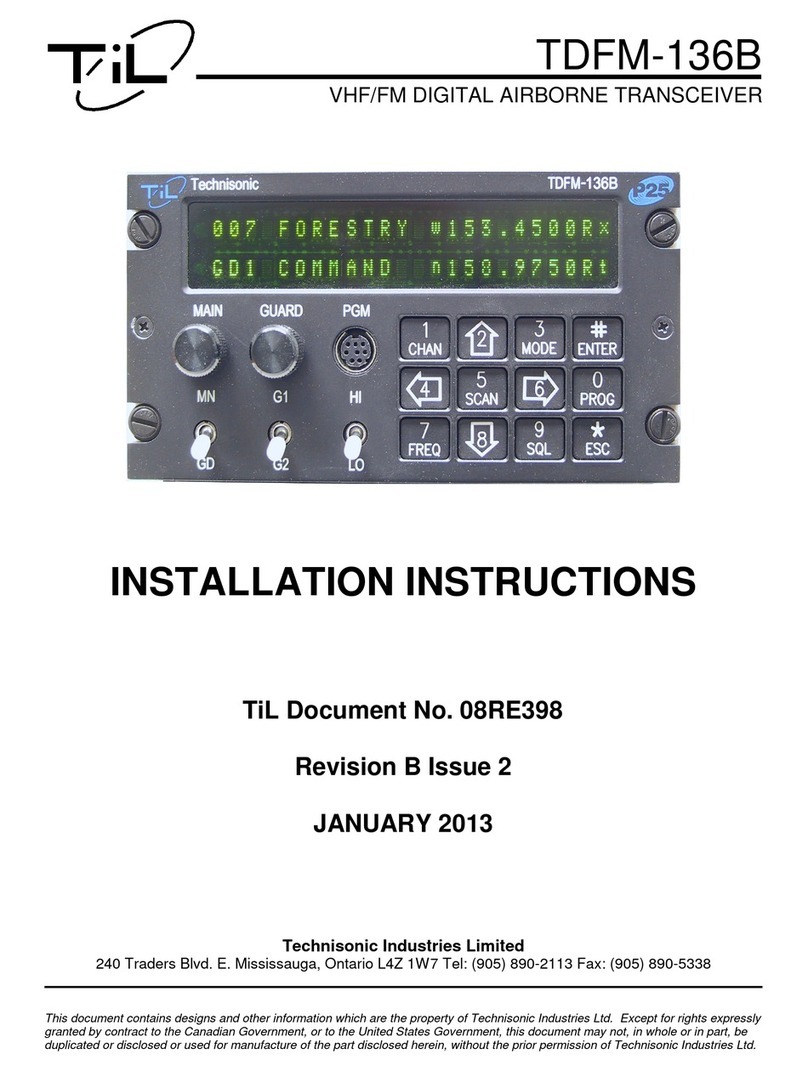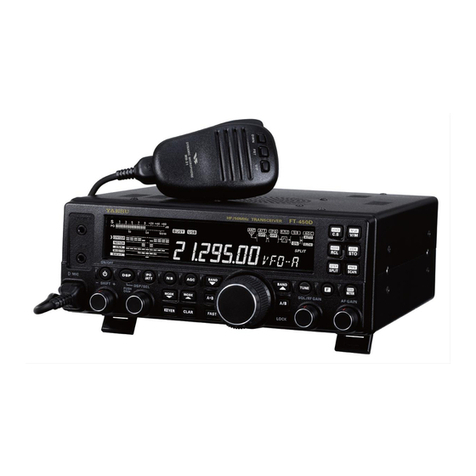Icom IC-G88 User manual

OPERATING GUIDE
Iç-G88
VHF TRANSCEIVER

i
INTRODUCTION
PREFACE
We appreciate you choosing Icom for your communication needs.
The MDC 1200 signaling system is built into your IC-G88 vhf transceiver.
IMPORTANT
FIRST, CAREFULLY READ INSTRUCTIONS qand wthat are provided with the transceiver.
SAVE THIS OPERATING GUIDE— This operating guide contains additional important operating instructions for
the IC-G88 vhf transceiver.
taBLe Of cOntents
PREFACE.............................................................................. i
IMPORTANT.......................................................................... i
1 ACCESSORIES...........................................................1–2
Accessory attachments....................................................1
DAntenna........................................................................1
DBattery pack .................................................................1
DBelt clip.........................................................................1
DJack cover ....................................................................2
2 PROGRAMMABLE KEY FUNCTIONS .......................3–4
Programmable key functions............................................3
3 MDC 1200 SYSTEM OPERATION ..................................5
About the MDC 1200 system ..........................................5
Receiving .........................................................................5
DReceiving a PTT ID......................................................5
Transmitting......................................................................5
DTransmitting a PTT ID...................................................5
4 SET MODES....................................................................6
VFO Set mode .................................................................6
User Set mode .................................................................7
Icom, Icom Inc. and Icom logo are registered trademarks of Icom Incorpo-
rated (Japan) in Japan, the United States, the United Kingdom, Germany,
France, Spain, Russia, Australia, New Zealand, and/or other countries.
All other products or brands are registered trademarks or trademarks of
their respective holders.

Section 1
1
ACCESSORIES
Accessory attachments
DAntenna
Connect the supplied antenna to the antenna connector.
DBattery pack
To attach or detach the battery pack:
Attach or detach the battery pack, as illustrated to the
right.
DBelt clip
To attach the belt clip:
qRemove the battery pack from the transceiver, if it
is attached.
wSlide the belt clip in the direction of the arrow un-
til the belt clip locks in place, and makes a ‘click’
sound.
To detach the belt clip:
qRemove the battery pack from the transceiver, if it
is attached.
wLift the tab up (q), and slide the belt clip in the
direction of the arrow (w).
q
w
w
qq
To attach
To attach
To detach
To detach
q
w
Ta b
CAUTION:
• NEVER carry the transceiver by holding only the
antenna.
• DO NOT connect any antenna other than that is sup-
plied with the transceiver.
• Transmitting without an antenna may damage the
transceiver.

1
2
ACCESSORIES
DJack cover
To attach the jack cover:
qPlace the jack cover over the speaker-microphone
jack.
wInsert and tighten the screws.
To detach the jack cover:
zUnscrew the screws using a Phillips screwdriver.
xDetach the jack cover to connect a speaker-micro-
phone or a headset.
Accessory attachments (Continued)
x
z
z
w
w
q
CAUTION: The transceiver meets IP67 requirements
for dust-tight and waterproof protection, only when
the jack cover or the optional HM-168LWP speaker
microphone is attached.

Section 2
3
PROGRAMMABLE KEY FUNCTIONS
Programmable key functions
If you use the CS-G88 programming software
(purchase separately), you can assign the functions
described below to [P0], [P1], [P2], [P3], [TOP], [UP],
and [DOWN].
CH Up, CH Down (UP, DOWN)
➥In the VFO mode, push to set the frequency.
➥In the Memory mode, push to select a channel.
➥In the Set mode, push to select an option for the
item.
Moni / Favorite CH Rewrite
➥Push to turn the Monitor function ON or OFF. (Open
or close the squelch)
➥In the Memory mode, hold down for 1 second to as-
sign the selected Memory CH to the current selec-
tor position.
Scan
➥Push to start or cancel a scan.
➥In the Memory mode,
hold down for 1 second to set
the channel as the Scan-tagged or untagged chan-
nel.
Prio A, Prio B
➥
Push to select priority A/B channel.
Prio A (Rewrite), Prio B (Rewrite)
➥Push to select the Priority A/B channel.
➥Hold down to assign the selected channel to the
Priority A/B channel.
MR–CH 1 ~ MR–CH 4 (MEMORY CHANNELS 1 ~ 4 )
➥
Push to select memory channel 1, 2, 3, or 4, if set.
Lock
➥Hold down for 1 second to turn the Key Lock func-
tion ON or OFF.
•All assignable keys except the following are electroni-
cally locked: [Shift], [Lock], [Surveillance] and [PTT].
High/Low
➥Push to select the output power.
Wide/Narrow
➥Push to temporarily switch the bandwidth to Wide,
or Narrow.
DTMF Autodial
➥Push to enter the DTMF channel selection mode.
Then, select a DTMF channel using [UP] or
[DOWN]. After selecting the channel, push this key
again to transmit the selected DTMF code.
Re-dial
➥Push to transmit the last-transmitted DTMF code.
Surveillance
➥Hold down for 1 second to turn ON the Surveillance
function.
• When the Surveillance function is ON, beeps do not
sound and the LED indicator does not light, even when
receiving a signal, or pushing a key.
➥Push to turn OFF the Surveillance function.
Siren
➥Hold down for 1 second to emit a siren.
• This function can be used for situations other than an
emergency alert, such as a security alarm.
The transceiver emits the siren until the power is turned
OFF.
Scrambler
➥Push to turn the Voice Scrambler function ON or
OFF.
Compander
➥Push to turn the Compander function ON or OFF.
• The Compander function reduces noise components
from the transmitted audio to provide clear communica-
tion.
NOTE: About the default settings of these keys, See
PANEL DESCRIPTION described in INSTRUC-
TIONS w.
NOTE: The last-transmitted DTMF code will be
cleared after turning OFF the transceiver.
NOTE: Congure a DTMF code to transmit using the
CS-G88 programming software.

2
4
PROGRAMMABLE KEY FUNCTIONS
Programmable key functions (Continued)
VFO / User Set Mode
➥Push to enter the VFO Set mode.
•The VFO Set mode is used to change settings for the
operation in the VFO mode.
➥Hold down for 1 second to enter the User Set mode.
•The User Set mode is used to set infrequently changed
values or status of functions without using a PC.
➥In the User/VFO mode, push this key to select an
item, and then push [UP] or [DOWN] to change the
value or setting.
➥In the User/VFO mode, hold down for 1 second to
exit the User/VFO Set mode.
Sp. Func 1/2
➥Reserved for future function.
Announce
➥
Push to turn the Channel Announce function ON or OFF.
• In the Memory mode, the transceiver announces the
selected channel number.
Shift
➥Push to switch the key functions, assigned into the
Normal mode and the Shift mode. The Shift mode en-
ables a programmable function key to have two functions.
1. Push to turn ON the Shift mode key functions.
• “SHIFT ON” is briey displayed.
2. Push another key to activate its secondary func-
tion.
3. Push [Shift] again to turn OFF the function.
• “SHIFT OFF” is briey displayed, and then the trans-
ceiver returns to the Normal mode.
VFO / Memory Mode
➥Push to toggle between VFO and Memory modes.
➥In the VFO mode, hold down for 1 second to write
the VFO data to the selected Memory channel.
➥In the Memory mode, hold down for 1 second to
copy the Memory channel data to the VFO.
Duplex / Sub Audible Tone
➥Push to select the Duplex mode from DUP–, DUP+
and OFF.
➥Hold down for 1 second to select a Sub Audible
tone from Repeater tone, TSQL (Tone Squelch),
TSQL with Pocket Beep, DTCS-TX, DTCS, DTCS
with Pocket Beep and tone OFF.

5
MDC 1200 SYSTEM OPERATIONSection 3
The MDC 1200 signaling system enhances your trans-
ceiver’s capabilities. You can receive or transmit a PTT
ID. PTT ID is a calling station ID that is sent by pushing
or releasing [PTT].
An additional feature of the MDC 1200 system included
in Icom transceivers is called aliasing. Each transceiver
on the system has a unique ID number. Aliasing is a
substitute for this ID number and you can give an al-
phanumeric name for each station ID. In transmit, you
can use this alias to select a transceiver to call. In re-
ceive, the alias of the calling station is displayed in-
stead of the ID.
NOTE:
To use the MDC 1200 system, set the related set-
tings by using the CS-G88 programming software
(purchase separately).
The factory default is not set to allow the system op-
eration.
About the MDC 1200 system
Receiving Transmitting
DReceiving a PTT ID
1. When a PTT ID is received:
• Beeps sound.
• The calling station ID (or alias) is displayed.
< Calling station ID >
< Alias >
2. Hold down [PTT] and speak into the microphone.
3. Release [PTT] to receive a response.
DTransmitting a PTT ID
Another person can view your station ID. If the same
alias is set at the receiving side, the alias is displayed
instead of the station ID.
1. Push [PTT] to make a call.
2. Beeps sound.
3. Your station ID will be transmitted when you push
[PTT] (at the beginning of transmission) or release it
(at the end of transmission), depending on the set-
ting in the CS-G88.

Section 4
6
SET MODES
User Set mode
Backlight
Select a state of the backlight.
• ON: The backlight turns ON
all the time.
• AUT: When pushing any key
(except [PTT]), the backlight automatically
turns ON for 5 seconds.
• AU2: When changing the displayed contents of the
LCD, the backlight automatically turns ON for
5 seconds.
• OFF: Turns OFF the backlight.
Beep ON/OFF
Turn the key-touch beeps ON or OFF.
• ON: When you push a key,
the beep sounds.
• OFF: The function is OFF, for a
silent operation.
Beep Level
Set the beep and announce
output level. When you select
a Linked option, the beep level
can be adjusted by [VOL].
• 1 (minimum) – 5 (maximum)
•
1(minimum) – 5(maximum)
: Linked with the audio level. Rotate [VOL] to ad-
just the beep level.
Ringer Level
Set the ringer level. When you
select a Linked option, the
ringer level can be adjusted by
rotating [VOL].
• 1 (minimum) – 5 (maximum)
•
1(minimum) – 5(maximum)
: Linked with the audio level. Rotate [VOL] to ad-
just the ringer level.
SQL (Squelch) Level
Sets the SQL level. The
squelch function suppresses
the noise output from a speaker
when no signal is received.
• 0: SQL Open
• 2: SQL Threshold
• 9: SQL Tight
AF Min Level (Minimum audio output level)
Sets the minimum audio output
level. This function determines
the minimum audio output level
not to let the audio level be-
come lower than the set level.
• 0 (minimum) ~ 255 (maximum)
Mic Gain
Sets the microphone sensitivity.
Higher values make the micro-
phone more sensitive to the
user's voice.
• 1 (minimum) ~ 4 (maximum)
Battery Voltage Display
Select whether or not to display
the battery voltage, when turn-
ing ON the transceiver.
• ON:
Displays the battery voltage for 2 seconds.
• OFF:
Does not display the battery voltage.
Signal Moni
Select whether or not to release
the mute while using a DTMF
code signaling.
• ON: The mute is released
while transmitting a DTMF Code.
• OFF: The mute is not released while transmitting a
DTMF Code.
The are 2 Set modes: User Set mode and VFO Set mode.
NOTE:
Beep: Any sound except ringers.
Ringer: Sounds when receiving a call.
The User Set mode enables you to change various settings. You can “customize” the transceiver operation to suit
your preferences and operating style.
Entering the User Set mode:
➥Hold down [VFO / User Set Mode] for 1 second to
enter the User Set mode.
•
While in the User Set mode, push [VFO / User Set Mode]
again to select an item, and then change the value or
setting by pushing [UP] or [DOWN].
Exiting the User Set mode:
➥Hold down [VFO / User Set Mode] again to exit the
User Set mode.

4
7
SET MODES
VFO Set mode
Tuning Step
When you select the operating
frequency by pushing [UP] or
[DOWN], the frequency changes in this selected
tuning step.
The set tuning step is also used for a VFO scan.
•
Select 5, 10, 12.5, 15.0, 20.0, 25.0, 30.0 or 50.0. (in kHz)
Reverse Duplex
Selects “ON” when reversing
the duplex frequency.
•
Select “OF” (OFF) for Normal Duplex communications.
Frequency offset
Sets the frequency offset for the
duplex operation.
In the duplex mode, the transmit
frequency shifts up or down from the receive fre-
quency by the offset amount.
When the Reverse Duplex is set to OFF, the transmit
frequency shifts from the operating frequency.
When the Reverse Duplex is set to ON, the receive
frequency shifts from the operating frequency.
• Set between 0 ~ 20 (in MHz)
DTCS Code
Selects the DTCS code for the
DTCS squelch operation.
Settable DTCS codes:
Output Power
Selects the default output
power of each channel.
•
Select L1 (Low1: 1 W), L2 (Low2: 2 W) or H (High: 5.5 W).
TIP: Lower output power during short-range communica-
tions may reduce the possibility of interference to
other stations.
Bandwidth
Sets the bandwidth (channel
spacing).
• Select N (Narrow: 12.5 kHz) or W (Wide: 25 kHz).
Repeater Tone Frequency
Sets the subaudible tone
frequency that is needed to
access the repeater.
Settable frequencies:
Tone Squelch Frequency
Sets the CTCSS tone fre-
quency for the tone squelch
operation.
Settable frequencies:
Exiting the VFO Set mode:
➥Hold down [VFO / User Set Mode] again to exit the
VFO Set mode.
The VFO Set mode enables you to change various settings for the operation in the VFO mode. You can change the
operating condition in this mode.
Entering the VFO Set mode:
➥
Push [VFO / User Set Mode] to enter the VFO Set mode.
• While in the VFO Set mode, push [VFO / User Set
Mode]again to select an item, and then change the
value or setting by pushing [UP] or [DOWN].
023
025
026
031
032
036
043
047
051
125
131
132
134
143
152
155
156
162
251
261
263
265
271
306
311
315
331
423
431
432
445
464
465
466
503
506
516
532
546
565
606
612
624
627
631
054
065
071
072
073
074
114
115
116
165
172
174
205
223
226
243
244
245
343
346
351
364
365
371
411
412
413
632
654
662
664
703
712
723
731
732
734
743
754
67.0
69.3
71.0
71.9
74.4
77.0
79.7
82.5
85.4
88.5
91.5
94.8
97.4
100.0
103.5
107.2
110.9
114.8
118.8
123.0
127.3
131.8
136.5
141.3
146.2
151.4
156.7
159.8
162.2
165.5
167.9
171.3
173.8
177.3
179.9
183.5
186.2
189.9
192.8
196.6
199.5
203.5
206.5
210.7
218.1
225.7
229.1
233.6
241.8
250.3
254.1
67.0
69.3
71.0
71.9
74.4
77.0
79.7
82.5
85.4
88.5
91.5
94.8
97.4
100.0
103.5
107.2
110.9
114.8
118.8
123.0
127.3
131.8
136.5
141.3
146.2
151.4
156.7
159.8
162.2
165.5
167.9
171.3
173.8
177.3
179.9
183.5
186.2
189.9
192.8
196.6
199.5
203.5
206.5
210.7
218.1
225.7
229.1
233.6
241.8
250.3
254.1
(Continued on the next page.)

4SCAN OPERATION
8
DTCS Polarity
Sets the DTCS polarity for
transmit and receive.
• Select “RR” (TX/RX Reverse), “RN” (TX Reverse,
RX Normal), “NR” (TX Normal, RX Reverse) or “NN”
(TX/RX Normal).
TX Inhibit
Selects whether or not to inhibit
transmitting on the channel.
• Select “OF” (OFF) to inhibit transmitting.
VFO Set mode (Continued)

1-1-32 Kamiminami, Hirano-ku, Osaka 547-0003, Japan
A7450-3EX
© 2018 Icom Inc.
Other manuals for IC-G88
2
Table of contents
Other Icom Transceiver manuals
Popular Transceiver manuals by other brands
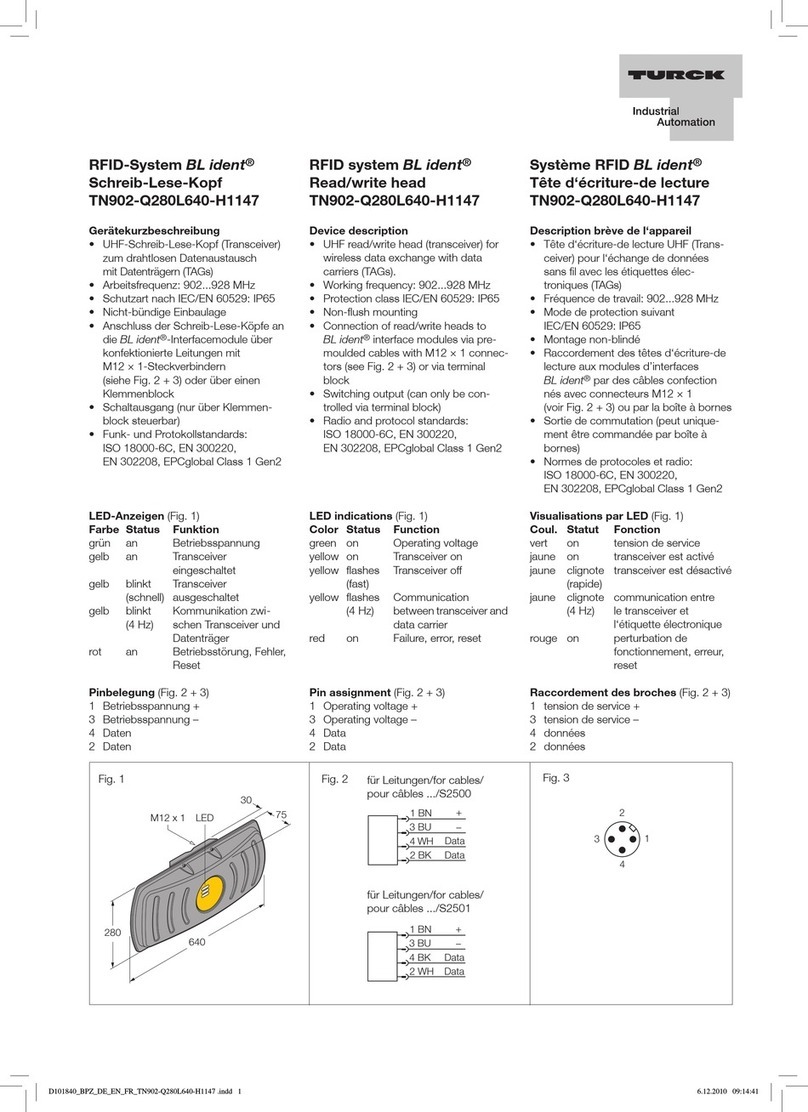
turck
turck BL ident TN902-Q280L640-H1147 quick start guide

Verterx Standard
Verterx Standard VX-2200 operating manual
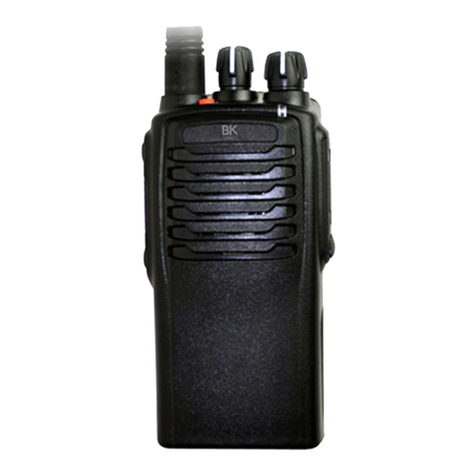
RELM
RELM RP7200 owner's manual
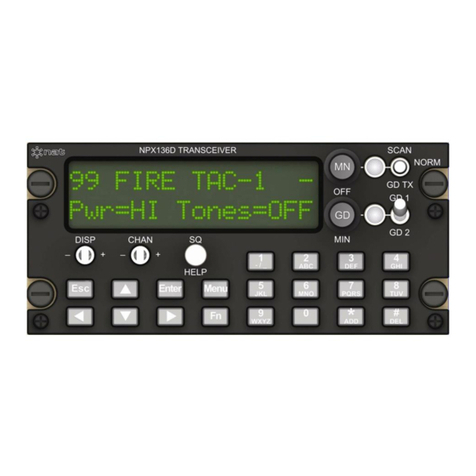
Nat
Nat NPX136D Series Installation and operation manual
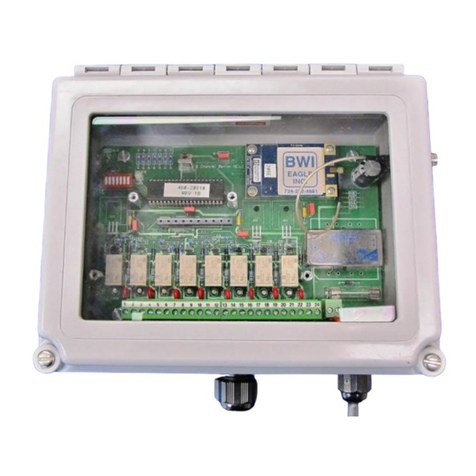
BWI Eagle
BWI Eagle AIR-EAGLE XLT PLUS 461-20800-AC Product information bulletin

Hobbes
Hobbes GIGA-X manual


